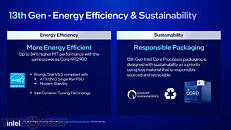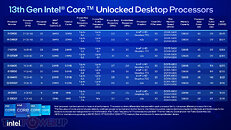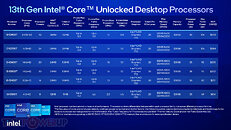- Joined
- Oct 9, 2007
- Messages
- 47,677 (7.43/day)
- Location
- Dublin, Ireland
| System Name | RBMK-1000 |
|---|---|
| Processor | AMD Ryzen 7 5700G |
| Motherboard | Gigabyte B550 AORUS Elite V2 |
| Cooling | DeepCool Gammax L240 V2 |
| Memory | 2x 16GB DDR4-3200 |
| Video Card(s) | Galax RTX 4070 Ti EX |
| Storage | Samsung 990 1TB |
| Display(s) | BenQ 1440p 60 Hz 27-inch |
| Case | Corsair Carbide 100R |
| Audio Device(s) | ASUS SupremeFX S1220A |
| Power Supply | Cooler Master MWE Gold 650W |
| Mouse | ASUS ROG Strix Impact |
| Keyboard | Gamdias Hermes E2 |
| Software | Windows 11 Pro |
Intel today expanded its 13th Gen Core "Raptor Lake" Socket LGA1700 desktop processor family with several new 65 W mainstream models. These include all the SKUs that lack an unlocked multiplier, aren't meant for CPU overclocking, and come with slightly lower frequencies and tighter power-management than the unlocked K-series SKUs the company debuted the series with in 2022. The retail packages of these processors include stock Intel fan-heatsinks similar to those the company includes with its 12th Gen "Alder Lake" 65 W processors.
The series is led by the Core i9-13900, an 8P+16E core processor with P-core base frequency of 2.00 GHz, P-core maximum boost frequency of 5.60 GHz, E-core base frequency of 1.50 GHz and 4.20 GHz; and the full 36 MB of L3 cache available on the silicon. The processor base power value is 65 W, and the maximum turbo power is 219 W. Intel lists the MSRP of these processors at $550, a variant without integrated graphics, the i9-13900F, can be had for $524. The Core i7-13700 positioned a notch below, is an 8P+8E processor, with a P-core boost frequency of up to 5.20 GHz, a slightly better 2.10 GHz E-core boost, 30 MB of L3 cache, and the same 219 W MTP value. The i7-13700 is priced at $384, and the iGPU-disabled.



Things get very interesting with the way Intel sub-segmented the 13th Gen Core i5 series. The unlocked K-series 13th Gen Core i5 chips are 6P+8E, based on the same "Raptor Lake-S" silicon as the other K-series SKUs, with two each of P-cores and E-core clusters disabled. The locked Core i5 chips appear to be very different looking at their "total L2 cache" counts mentioned in the Intel specs. The Core i5-13600 and i5-13500 are 6P+8E SKUs, while the i5-13400 and i5-13400F are 6P+4E. This is a clever move by Intel to prevent the i5-13400/F from soaking up all sales away from the i5-13500/13600. But the question remains on their L2 cache sizes.
The i5-13500 and i5-13600 come with 11.5 MB of total L2 cache, which is only possible if the L2 cache per P-core is 1.25 MB (like the "Golden Cove" cores on "Alder Lake" chips, and if the L2 cache per "Gracemont" E-core cluster is 2 MB. These are in sharp contrast to the Core i5-13600K, which has 2 MB L2 cache per P-core, and 4 MB L2 cache per E-core cluster. There had been rumors that 13th Gen Core i5 and Core i3 65 W processors are based on the older "Alder Lake" architecture with generational increases in CPU core-counts; but Intel wouldn't confirm this. The L2 caches certainly seem to suggest that this is the case.
The Core i5-13600 is a 6P+8E chip with its P-cores clocked up to 5.00 GHz, E-cores up to 2.70 GHz; whereas the i5-13500 has slightly lower clock speeds of up to 4.80 GHz P-core boost, and up to 2.50 GHz E-core boost. The shared L3 cache size is set at 24 MB. Both models come with 65 W processor base power, and 154 W maximum turbo power values. The i5-13600 is priced at $255, and the i5-13500 at $232.
The Core i5-13400 and i5-13400F, as we mentioned, are 6P+4E chips. Both come with P-core boost frequencies of up to 4.60 GHz, E-core boost up to 2.50 GHz, and a shared L3 cache size of 20 MB. The i5-13400 is priced at $221 or just $11 away from getting four more E-cores and a little more L3 cache with the i5-13500; while the iGPU-disabled i5-13400F goes for $196. Both these chips have their maximum turbo power set at 148 W.

The only two Core i3 SKUs with this generation are the Core i3-13100 and i3-13100F, and are 4P+0E chips that are very likely based on the 6P+0E "Alder Lake" with two P-cores disabled. Each of the four P-cores gets 1.25 MB L2 cache, and the four P-cores share 12 MB of L3 cache. The i3-13100 is priced at $134, and the i3-13100F at $109. The i3-13100 has 65 W base power and 89 W maximum turbo power, while the i3-13100F lacks iGPU, and has a slightly lower base power of 58 W. Both chips have their P-core boost frequency set up to 4.50 GHz.
Besides these, Intel introduced a small lineup of 13th Gen Core i9, Core i7, Core i5, and Core i3 T-series power-efficient SKUs, with their base power set at 35 W, and maximum turbo power set significantly lower than the non-T parts, ranging between 69 W to 106 W, which should mean aggressive power-management that's as tight as H-segment mobile processors.
View at TechPowerUp Main Site
The series is led by the Core i9-13900, an 8P+16E core processor with P-core base frequency of 2.00 GHz, P-core maximum boost frequency of 5.60 GHz, E-core base frequency of 1.50 GHz and 4.20 GHz; and the full 36 MB of L3 cache available on the silicon. The processor base power value is 65 W, and the maximum turbo power is 219 W. Intel lists the MSRP of these processors at $550, a variant without integrated graphics, the i9-13900F, can be had for $524. The Core i7-13700 positioned a notch below, is an 8P+8E processor, with a P-core boost frequency of up to 5.20 GHz, a slightly better 2.10 GHz E-core boost, 30 MB of L3 cache, and the same 219 W MTP value. The i7-13700 is priced at $384, and the iGPU-disabled.



Things get very interesting with the way Intel sub-segmented the 13th Gen Core i5 series. The unlocked K-series 13th Gen Core i5 chips are 6P+8E, based on the same "Raptor Lake-S" silicon as the other K-series SKUs, with two each of P-cores and E-core clusters disabled. The locked Core i5 chips appear to be very different looking at their "total L2 cache" counts mentioned in the Intel specs. The Core i5-13600 and i5-13500 are 6P+8E SKUs, while the i5-13400 and i5-13400F are 6P+4E. This is a clever move by Intel to prevent the i5-13400/F from soaking up all sales away from the i5-13500/13600. But the question remains on their L2 cache sizes.
The i5-13500 and i5-13600 come with 11.5 MB of total L2 cache, which is only possible if the L2 cache per P-core is 1.25 MB (like the "Golden Cove" cores on "Alder Lake" chips, and if the L2 cache per "Gracemont" E-core cluster is 2 MB. These are in sharp contrast to the Core i5-13600K, which has 2 MB L2 cache per P-core, and 4 MB L2 cache per E-core cluster. There had been rumors that 13th Gen Core i5 and Core i3 65 W processors are based on the older "Alder Lake" architecture with generational increases in CPU core-counts; but Intel wouldn't confirm this. The L2 caches certainly seem to suggest that this is the case.
The Core i5-13600 is a 6P+8E chip with its P-cores clocked up to 5.00 GHz, E-cores up to 2.70 GHz; whereas the i5-13500 has slightly lower clock speeds of up to 4.80 GHz P-core boost, and up to 2.50 GHz E-core boost. The shared L3 cache size is set at 24 MB. Both models come with 65 W processor base power, and 154 W maximum turbo power values. The i5-13600 is priced at $255, and the i5-13500 at $232.
The Core i5-13400 and i5-13400F, as we mentioned, are 6P+4E chips. Both come with P-core boost frequencies of up to 4.60 GHz, E-core boost up to 2.50 GHz, and a shared L3 cache size of 20 MB. The i5-13400 is priced at $221 or just $11 away from getting four more E-cores and a little more L3 cache with the i5-13500; while the iGPU-disabled i5-13400F goes for $196. Both these chips have their maximum turbo power set at 148 W.

The only two Core i3 SKUs with this generation are the Core i3-13100 and i3-13100F, and are 4P+0E chips that are very likely based on the 6P+0E "Alder Lake" with two P-cores disabled. Each of the four P-cores gets 1.25 MB L2 cache, and the four P-cores share 12 MB of L3 cache. The i3-13100 is priced at $134, and the i3-13100F at $109. The i3-13100 has 65 W base power and 89 W maximum turbo power, while the i3-13100F lacks iGPU, and has a slightly lower base power of 58 W. Both chips have their P-core boost frequency set up to 4.50 GHz.
Besides these, Intel introduced a small lineup of 13th Gen Core i9, Core i7, Core i5, and Core i3 T-series power-efficient SKUs, with their base power set at 35 W, and maximum turbo power set significantly lower than the non-T parts, ranging between 69 W to 106 W, which should mean aggressive power-management that's as tight as H-segment mobile processors.
View at TechPowerUp Main Site





